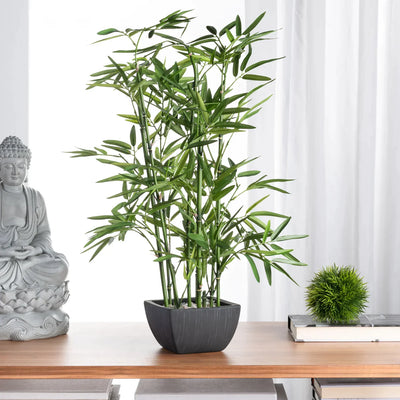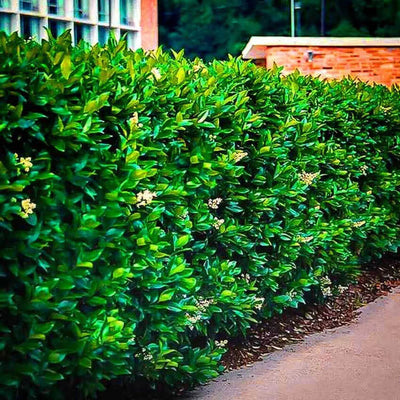Simple, Classy, and Clean
Gardening is not just about planting beautiful flowers and shrubs; it's also a form of artistry where every element, from plants to design, contributes to the overall aesthetic. Architectural simplicity in gardening with native plants is a philosophy that emphasizes clean lines, minimalism, and the use of well-suited plants to their natural environment. In this exploration, we will delve into the concept of architectural simplicity in gardening while focusing on specific native plants that can be used to achieve this aesthetic. We will discuss the art of topiary, the elegance of ribbon grass, the fiery allure of red hot pokers, the versatility of bamboo, the grace of horsetail plants, the vibrancy of coral red dogwood, the timelessness of boxwoods, the functionality of privets, and the importance of symmetry in garden design.
Topiary: The Art of Shaping Nature
Topiary is a garden design technique that involves trimming and shaping plants into geometric or artistic forms. While it may seem intricate, topiary can be part of an architecturally simple garden when used sparingly. Native plants like boxwoods and privets can be sculpted into elegant shapes, adding structure and order to the landscape.
Ribbon Grass: Subtle Elegance
Ribbon grass, scientifically known as Phalaris arundinacea, is a native plant that exudes simplicity and elegance. Its slender leaves feature a striking green and white variegation that lends a touch of architectural interest to any garden. Its low maintenance requirements and natural beauty make it a prime candidate for an architecturally simple garden.
Red Hot Pokers: A Burst of Color
Red hot pokers (Kniphofia uvaria) are native to South Africa but have found a home in gardens worldwide. Their bold, torch-like flowers in shades of red, orange, and yellow can provide a stunning focal point in a garden while maintaining a sense of simplicity. Their blooms' verticality and architectural nature make them a perfect choice for an uncomplicated garden design.
Bamboo: Graceful and Versatile
Bamboo, a native plant to various regions worldwide, is renowned for its versatility and architectural appeal. Its tall, slender stems and lush foliage can create natural screens or focal points in the garden. Bamboo embodies simplicity by providing structure without overwhelming the space, making it an ideal addition to an architecturally simple garden.
Horsetail Plants: Graceful Simplicity
Horsetail plants (Equisetum hyemale) are native to North America and have a unique architectural appeal. Their segmented, vertical stems rise gracefully from the ground, adding a touch of simplicity and symmetry to the garden. Horsetail plants thrive in moist conditions and can be used to create a minimalist water feature.
Coral Red Dogwood: Vibrant Focal Point
Coral red dogwood (Cornus sericea) is a native shrub that adds color to an architecturally simple garden. Its bright red stems shine against a backdrop of green, providing a focal point without the need for complex design elements. Pruning can be employed to maintain a clean, structured appearance.
Boxwoods: Timeless Elegance
Boxwood's evergreen foliage and ability to be shaped into various forms epitomize timeless elegance in garden design. These native plants are frequently used to create hedges, topiaries, and symmetrical shapes, enhancing a garden's architectural simplicity while providing structure and order.
Privets: Functionality and Form
Privets, native to Europe and Asia, are prized for their functionality in creating hedges and screens while maintaining a clean, structured appearance. Their small, dark green leaves and dense growth make them a valuable addition to architecturally simple gardens, serving as both a backdrop and a design element.
The Importance of Symmetry
Symmetry is vital in creating a balanced and harmonious garden with architectural simplicity. Symmetrical plantings, pathways, and focal points help maintain order and calm. Plants like boxwoods, privets, and topiaries are well-suited for achieving symmetry in garden design, providing a clear and organized layout.
Architectural simplicity in gardening with native plants is an approach that celebrates clean lines, minimalism, and the use of plants that thrive in their natural environments. Whether it's through the art of topiary, the grace of ribbon grass, the vibrancy of red hot pokers, the versatility of bamboo, the elegance of horsetail plants, the striking allure of coral red dogwood, the timelessness of boxwoods, or the functionality of privets, native plants can help achieve this aesthetic. Embracing symmetry in garden design further enhances the sense of order and balance, ensuring that architectural simplicity remains at the forefront of the garden's charm. By choosing native plants and adhering to these principles, gardeners can create beautiful and effortlessly elegant landscapes.




